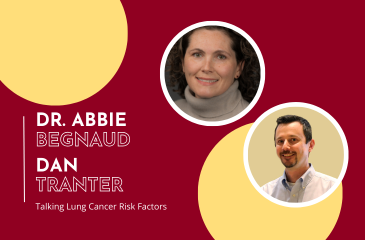A Conversation on Lung Cancer Risks with Dr. Abbie Begnaud and Dan Tranter
November marks Lung Cancer Awareness Month, and to shed light on this critical topic, we sat down with Dr. Abbie Begnaud and Dan Tranter for a conversation on lung cancer, covering everything from signs and symptoms to early detection, screening, and risk factors. Don’t miss Dr. Begnaud and Dan Tranter as our special guests at the upcoming Fireside Chat on November 20!
What is your educational background? What intrigued you about your field of specialty?
Dr. Abbie Begnaud: After medical school I completed residency in internal medicine and fellowship in pulmonary and critical care medicine. I mostly chose my educational direction by following my instincts. I love the complex puzzles of understanding the inner workings of the body in internal medicine. And for reasons I can't fully explain, I've always been drawn to caring for people with lung cancer.
What is lung cancer and how does it happen?
Dr. Begnaud: Lung cancer occurs when abnormal cells grow out of control in the lungs. It can start out from exposure to toxic substances or inherited genetic abnormalities. Our bodies and immune systems are constantly fighting to repair injured cells and thwart the growth of abnormal cells. But when our bodies fail to control the balance of normal and abnormal cells, cells can grow out of control and become cancerous.
Are there any preventative measures that people can take against getting lung cancer?
Dr. Begnaud: The most important thing people can do to avoid lung cancer is minimize or avoid their exposure to inhaled toxic substances such as cigarette smoke or radon. If you smoke cigarettes, quitting is the most important thing you can do for your health. If you have not already tested your home for radon, testing and removing excess radon in your home can protect your whole family from this odorless and colorless cancer-causing gas.
What health disparities exist regarding lung cancer?
Dr. Begnaud: Many disparities exist around lung cancer and they are probably continuing to grow. A few decades ago, we did not have very good detection and treatment for lung cancer so nearly everyone who was diagnosed with lung cancer died within a short time. Now that we have better ways to screen, detect, diagnose, and treat lung cancer, there are opportunities for some people to get better lung cancer care than others. All along the spectrum of lung cancer from diagnosis to treatment, we see people with lower access to healthcare experiencing disparities, including racially marginalized groups, economically deprived groups, and people who live in rural areas.
How is your research/work advancing understanding of lung cancer and how we prevent/diagnose it?
Dr. Begnaud: I am working to raise awareness of lung cancer in general and the fact that anybody with lungs can get lung cancer. I am working to reduce the stigma of lung cancer, because no one deserves it. And I am also working to improve adoption of screening for lung cancer in healthcare organizations and communities disproportionately impacted by lung cancer.
Can you explain how radon exposure contributes to lung cancer risk, and why it’s a particular concern in Minnesota?
Dan Tranter: Radon is a colorless and odorless soil gas. It enters our homes and other buildings through the foundation and can build up to high levels. Because it is a type of radiation, when you breathe radon it can damage the lungs, which can lead to lung cancer. Minnesota has some of the highest radon levels in the U.S.; about 40 percent of our homes here in Minnesota are estimated to have elevated radon (at or above the EPA action level of 4 pCi/L).
What resources or programs does the Minnesota Department of Health (MDH) offer to help residents test and mitigate radon levels in their homes?
Dan: MDH has a radon education and outreach program. We work to raise awareness, encourage testing, and promote radon reduction (also called mitigation). We also analyze radon data to develop maps and studies about radon in Minnesota, and provide technical assistance on policy, such as codes, standards, and laws. MDH also licenses radon professionals. We credential about 400 people per year. We train these professionals through continuing education and create technical resources for them. Then we inspect their work to ensure accurate and reliable testing and effective radon mitigation across the state.
What steps can people take if they find elevated radon levels in their homes? Where can they access reliable information for radon mitigation?
Dan: MDH recommends hiring a licensed radon mitigation professional to lower radon in your home. You can find lists of licensed measurement and mitigation professionals on our website: mn.gov/radon. We also have information about testing (to help you decide whether further testing is needed), how to mitigate homes, and questions to ask a professional.
How does MDH work with local communities to raise awareness about radon risks and promote testing, especially in regions where radon levels are typically higher?
Dan: Every year, we distribute about 7,000 free radon test kits to around 100 local partners who work on public health, housing, and more. These partners provide the radon test kits to their community. We also conduct a multimedia awareness campaign across TV, radio, web, and social media to make the issue more visible for Minnesotans. And we complete many education and training programs that include brochures, presentations, community events, and continuing education training to further get the word out. Our work serves the entire state, but we have focused on areas with high radon and lower testing rates. In these areas in particular, we have completed targeted marketing, training programs, projects with local organizations, and specific social media campaigns.
